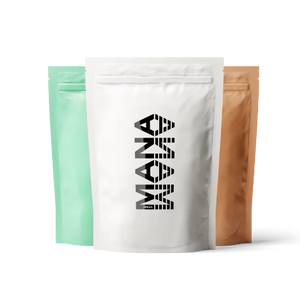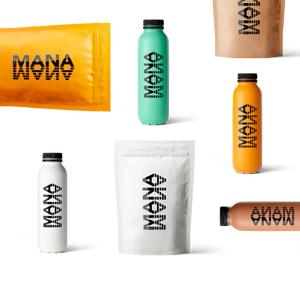
There is a lot that goes into giving Mana powders and drinks their taste, consistency, and nutritional values. You may not know it, but before we arrived at the first official recipe of Mana Powder in 2014, we went through hundreds of trial recipes.
The reason for this was that we did not want to compromise on either taste or nutrition. For example, some forms of nutrients in the initial versions, while rather tasty, proved not very absorbable by the body, making the end product “less” completely nutritious. Likewise, some of the ingredients we were using, even if highly nutritious and absorbable, didn’t always taste so great together.
Today, we think Mana is more nutritious and delicious than it’s ever been thanks to 6 years of tweaks, tests, and verifiable improvements. That being said, everything in it happens for a reason. Yet 3 ingredients often come under fire: soy, maltodextrin, and sucralose.
In the text that follows, we would like to address why each of these is used in Mana, and how it interacts with your body.
Isolated Soy Protein
Mana Powder and Mana Drink contain isolated soy protein for a number of reasons. First, the taste profile is very neutral and highly suitable to the remainder of the ingredients in Mana. Second, among plant proteins (rice, pea, hemp, etc.), soy protein is superior in terms of digestibility. (However, the latest clinical studies suggest that plant protein ranks second to animal protein in these respects, which is why we have increased the protein content in Mana above that which is recommended by the EFSA.) Third, it has a good profile of essential amino acids. And lastly, it is a good source of minerals and phytonutrients, in particular isoflavonoids.
So, why does soy not have the best reputation? It is sometimes accused of offsetting natural hormonal balances by providing an excess of phytoestrogens, i.e. non-steroidal derivatives of isoflavonoids that are structurally similar to estrogen. Due to this structural similarity, phytoestrogens have an affinity for estrogen receptors and other enzymes involved in estrogen metabolism, and thus modulate the function of estrogens [1]. Their effect on such receptors, however, is weaker than that caused by the body’s own hormones [2].
The main isoflavonoids/phytoestrogens in Mana are genistein, daidzein, and glycitein. Scientific literature attributes some positive effects to daidzein, which is an antioxidant [3] and anti-inflammatory [4] that can also help prevent chronic diseases associated with lifestyle [5]. Genistein is common in oriental diets that include soy, with average daily intake ranging from 20-80 mg [6]. Glycitein accounts for only 5-10% of the total isoflavones in soy-containing food products, and has weak estrogenic activity in comparison to other soy isoflavones [7]. A 1997 study of the population of Japan by Nagata et al. [8] revealed that overall daily isoflavonoid intake ranged from 20-50 mg; a second study [9] conducted in China measured it at 39.26 mg; and a third study [10] conducted in West Asia measured it at around 100 mg. None of these studies revealed any negative effects on health.

Despite the above, we use soy protein isolated using state-of-the-art technology that minimises the concentration of phytoestrogens in the end product. According to official lab analyses, Mana Powder and Mana Drink contain 4.7 mg of genistein, daidzein, and glycitein per serving. 5 servings, a daily portion, delivers 23.5 mg. This is in line with the standard daily phytoestrogen consumption of the average European. For comparison, a 2003 study by Branca [11] found that 23 mg are consumed daily in the Netherlands, and a 2012 study by Zamora-Ros [12] revealed this amount to be 24.9 mg in the United Kingdom and Northern Ireland.
Finally, with regard to men, clinical studies by Hamilton-Reeves et al. from 2010 [13], as well as by Mitchell et al. from 2001 [14], reported that the consumption of soy or isolated soy protein did not affect their level of sex hormones, or their quantity or quality of sperm.
In sum, the benefits of using soy in Mana far outweigh any evidence that it is harmful for health. We have been drinking it for years, and are yet to see any negative effects.
Maltodextrin
Maltodextrin is a starch-based polysaccharide modified from corn, rice, wheat, or potatoes. It is often used to thicken infant food, clinical nutrition products, and baked goods. In Mana, it also serves as an important source of carbohydrates.
By itself, maltodextrin has a rather high glycemic index (GI) of 86 or more. GI is a measure of how quickly a food raises blood glucose levels. In general, sugary and starchy foods rich in simple carbohydrates tend have high GIs. Maltodextrin is associated with these, which is why it is often criticized. However, in a complex food such as Mana, the GI of any single ingredient is not significant, as the total GI must account for all macronutrients.
A study we conducted on the glycemic and insulin indices of Mana Drink in cooperation with Charles University and a local university hospital in Prague, Czech Republic found that Mana Drink has a relatively low glycemic index (29) and insulin index (41), as well as relatively low carbohydrate content, making it suitable for use by diabetics within a framework of complex dietary treatment. We believe the same is true of Mana Powder, given that its nutritional composition is nearly identical to that of Mana Drink. The results of the study can be read here.

Mana has a low glycemic index, which means that it causes a steady rise and fall of blood glucose levels over time, for gradual release of energy.
In addition to the above, the maltodextrin we use in Mana is best-quality from European manufacturers, and itself has lower simple carbohydrate content than the forms of maltodextrin used in many other products. This may be another reason for the low GI of Mana.
As a whole, Mana provides both simple and complex carbohydrates for short- and long-term energy. Its main sources of carbs are maltodextrin, isomaltulose, oat fiber with beta-glucans, inulin from chicory, carrot fiber, and arabic and xanthan gum.
Sucralose
Because there are so many ingredients in Mana, some of which are rather bitter, something must “unify” the overall taste. Of all the sweeteners we’ve tried, sucralose does this best.
Mana is composed of 99.5% natural ingredients. Sucralose, however, is an artificial sweetener made from modified sucrose. Yet it is one of the safest known sweeteners used in food production. According to clinical studies, an absolutely safe daily dose of sucralose is 15 mg (0.015 g) or less per kg of bodyweight [15]. So, for example, for a 60 kilogram human, a safe dose of sucralose would be 900 mg (0.9 g) per day. A daily dose of Mana (5 servings) contains approximately 60 times lower than the recommended maximum.
Sucralose has not been shown to have any carcinogenic, reproductive, or neurological effects [16]. In the above-cited clinical study, repeated consumption of 0.136 g sucralose in healthy subjects for two weeks had no effect on glucose metabolism or insulin levels. Due to its high stability, sucralose is not metabolized in the body, does not accumulate in fats, and is easily excreted without causing any structural changes.
So, not only does sucralose taste good in combination with all other Mana ingredients, it is very practical with respect to safety and stability.
Conclusion
Without a doubt, eating too much of any one of the above ingredients would be unhealthy. The same is true for just about every other food. But Mana has been carefully crafted with a view to balance and harmony. Even if it was all you ate, you would not consume more soy than the average European, you would have a relatively low-carb diet and your consumption of maltodextrin would not lead to unhealthy spikes in blood glucose, and your consumption of sucralose would be well below the recommended daily maximum.
Nevertheless, keep in mind that Mana is intended for healthy adults and children above the age of 3, and is not meant for diagnostic or medicinal purposes. If you have any health restrictions, we recommend consulting a professional physician before use. Otherwise, enjoy!
Powder | Origin | Mark 6
____________
Sources:
[1] Messina MJ, Loprinzi CL. (2001) Soy for Breast Cancer Survivors: A Critical Review of the Literature, J Nutr. Nov;131(11 Suppl):3095S-108S. Review. https://doi.org/10.1093/jn/131.11.3095S
[2] Mitchell JH. et al. (2001). Effect of a phytoestrogen food supplement on reproductive health in normal males. Clin Sci (Lond). Jun;100(6):613-8. https://www.ncbi.nlm.nih.gov/pubmed/11352776
[3] Medeiros, PS. et al. (2016). Raman microspectroscopy for probing the impact of a dietary antioxidant on human breast cancer cells. Food Funct. Jun 15;7(6):2800-10. https://www.ncbi.nlm.nih.gov/pubmed/27227510
[4] Ahmad S. et al. (2016). Anti-arthritogenic and cardioprotective action of hesperidin and daidzein in collagen-induced rheumatoid arthritis. Mol Cell Biochem. Dec;423(1-2):115-127. Epub 2016 Oct 4. https://www.ncbi.nlm.nih.gov/pubmed/27704466
[5] Zaheer K, Humayoun Akhtar M. (2017) An updated review of dietary isoflavones: Nutrition, processing, bioavailability and impacts on human health, Crit Rev Food Sci Nutr. Apr 13;57(6):1280-1293. doi: 10.1080/10408398.2014.989958. Review. https://www.ncbi.nlm.nih.gov/pubmed/26565435
[6] Barnes S. et al. (1995). Rationale for the use of genistein-containing soy matrices in chemoprevention trials for breast and prostate cancer. JJ Cell Biochem Suppl. 22:181-7. https://www.ncbi.nlm.nih.gov/pubmed/8538197
[7] Song TT, et al. (1999) Estrogenic Activity of Glycitein, a Soy Isoflavone, J Agric Food Chem. 1999 Apr;47(4):1607-10. Erratum in: J Agric Food Chem Apr 10;50(8):2470.
[8] https://www.ncbi.nlm.nih.gov/pubmed/9457744 (Accessed 23 April 2020).
[9] Chen Z. et al. (1999) Usual dietary consumption of soy foods and its correlations with the excretion rate of isoflavonoid in overnight urine samples. Nutr Cancer. 33(1):82-7. https://www.ncbi.nlm.nih.gov/pubmed/10227048
[10] Bakker M.I. (2004) Dietary intake of phytoestrogens. RIVM report 320103002/2004. Online: http://rivm.openrepository.com/rivm/bitstream/10029/8888/1/320103002.pdf
[11] Branca F. (2003) Dietary phyto-oestrogens and bone health. Proc Nutr Soc. Nov;62(4):877-87. Review. https://www.ncbi.nlm.nih.gov/pubmed/15018488
[12] Zamora-Ros R. et al. (2012) Dietary intakes and food sources of phytoestrogens in the European Prospective Investigation into Cancer and Nutrition (EPIC) 24-hour dietary recall cohort. Eur J Clin Nutr. Aug;66(8):932-41. doi: 10.1038/ejcn.2012.36. Epub 2012 Apr 18. https://www.ncbi.nlm.nih.gov/pubmed/22510793
[13] Hamilton-Reeves JM. et al. (2009)Clinical studies show no effects of soy protein or isoflavones on reproductive hormones in men: results of a meta-analysis. Fertil Steril. Aug;94(3):997-1007. doi: 10.1016/j.fertnstert.2009.04.038. Epub 2009 Jun 12. Review. https://www.ncbi.nlm.nih.gov/pubmed/19524224
[14] Mitchell JH. et al. (2001) Effect of a phytoestrogen food supplement on reproductive health in normal males. Clin Sci (Lond). Jun;100(6):613-8. https://www.ncbi.nlm.nih.gov/pubmed/11352776
[15] Ahmad SY. et al. (2019) The effect of the artificial sweeteners on glucose metabolism in healthy adults: a randomized double-blinded crossover clinical trial. Appl Physiol Nutr Metab. Nov 7. doi: 10.1139/apnm-2019-0359. https://www.ncbi.nlm.nih.gov/pubmed/31697573
[16] Magnuson BA, Roberts A, Nestmann ER. (2017) Critical review of the current literature on the safety of sucralose. Food Chem Toxicol. Aug;106(Pt A):324-355. doi: 10.1016/j.fct.2017.05.047. Epub 2017 May 27. Review. https://www.ncbi.nlm.nih.gov/pubmed/28558975




